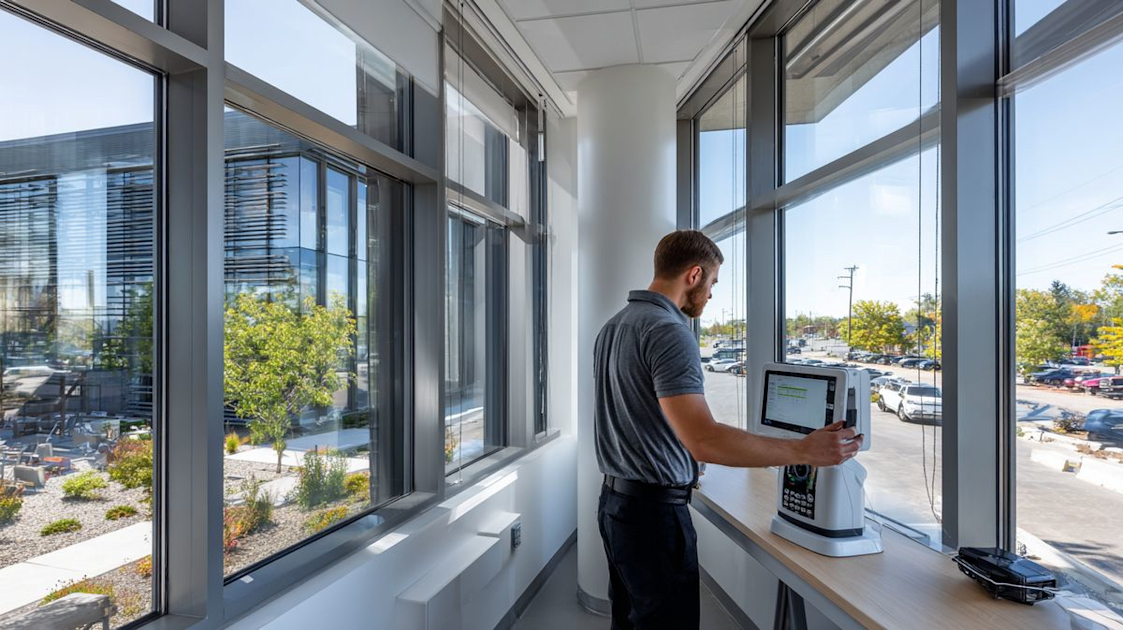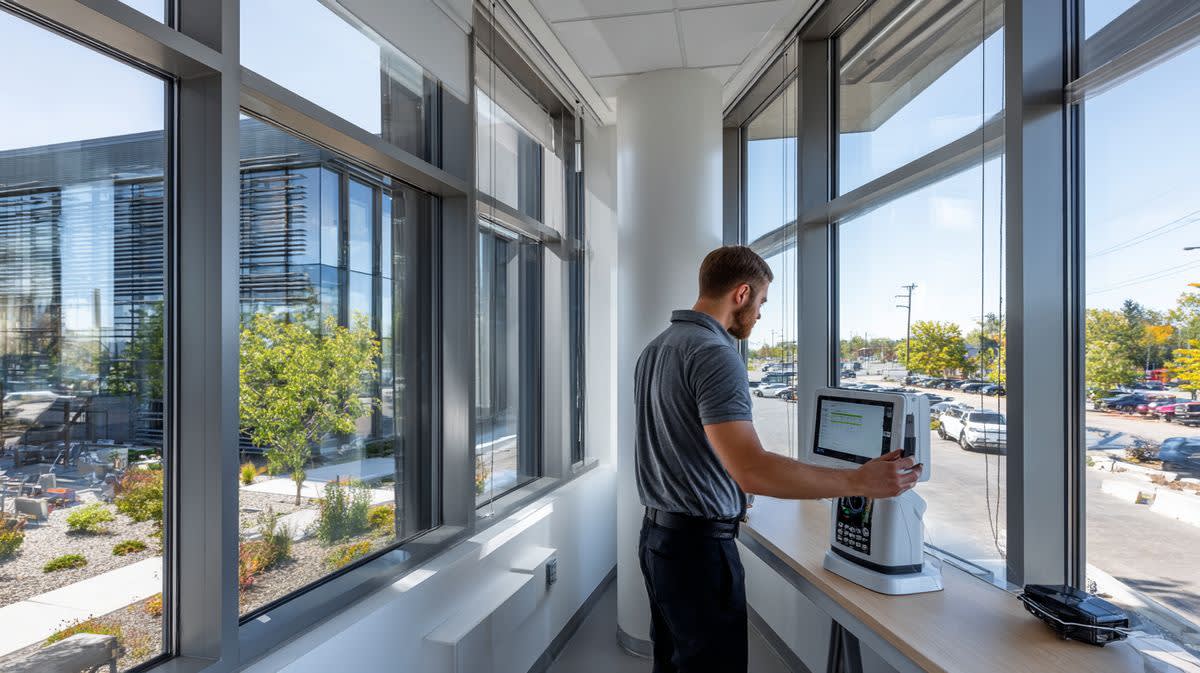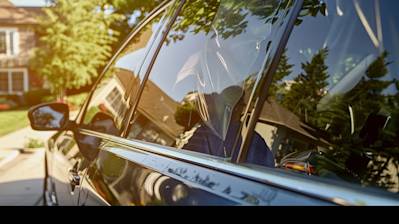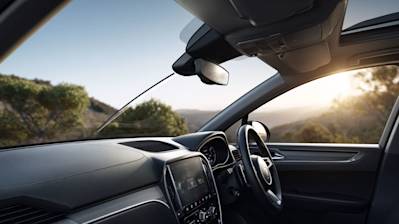Window tint meters are nifty tools designed to precisely measure the light transmission through a window, often on vehicles. If you’ve ever been curious about the legal compliance of your car's window tinting or you're just intrigued by how sunlight penetrates through tinted glass, this gadget is your best friend. They are essentially small, handheld devices that can give you a reading in seconds, determining just how much light passes through your tinted surfaces.
The Mechanics Behind Window Tint Meters
These devices operate using a light sensor and a laser, which work in tandem to assess the percentage of visible light transmission (VLT). The sensor detects how much light is transmitted through the glass, and the laser reads the intensity, giving a quick and straightforward VLT percentage. Basically, if your meter reads 70%, that means 70% of the visible light is getting through your window.
Types of Window Tint Meters
There are a few varieties of these meters, each with its own advantages depending on the user’s needs.
Handheld Devices
These are perhaps the most common type of window tint meters. Known for their portability, they’re a favorite among professionals and DIY enthusiasts alike. They're small, convenient, and can be carried around easily for quick checks wherever and whenever necessary.
In-line Meters
In-line tint meters are part of more sophisticated setups, often used in professional workshops or by law enforcement. They are typically larger and can provide more detailed readings, making them ideal for more thorough inspections.
Smartphone Attachment Meters
Technology continues to advance, and now you can find window tinting meters that attach to your smartphone. They harness your phone's processing power and display capabilities, turning it into an advanced metering tool. Perfect for tech lovers and those who appreciate multifunctional gadgets.
Why Use a Window Tint Meter?
The utility of a window tint meter extends beyond simple curiosity. They serve multiple vital functions in both professional and personal contexts.
Legal Compliance
One of the primary reasons for using a window tint reading device is to ensure that your vehicle’s window tinting complies with state and local regulations. These laws vary significantly; while some regions have very lax rules regarding tinting, others have strict limitations on how dark your tint can be. A window tint gauge can help you avoid fines and keep your vehicle fully legal.
Accurate Assessment
Window tint meters provide an accurate, trustworthy measure of how much light penetrates your windows. This precision is particularly crucial for businesses that offer window tinting services. Accurate assessments ensure customers are getting exactly what they pay for, building trust and credibility for the service provider.
For Personal Use
For car enthusiasts or people who’ve recently had their windows tinted, using a window tint meter can provide peace of mind. It helps individuals verify that they got the tint they wanted, and it's great for showing off or reassuring friends and family, especially for those who invested heavily in custom or high-tech tint.
How to Use a Window Tint Meter
You might be surprised at how straightforward these gadgets are to use. The process depends on the type of meter, but generally, it's as simple as embedding the device onto the window surface.
Step-by-Step Guide
- Power On the Meter: Start by switching on the device. Ensure that it's fully charged or loaded with fresh batteries if it's not a smartphone attachment.
- Calibrate If Necessary: Some devices require calibration. Follow the manufacturer's guidelines to ensure you’re getting an accurate reading.
- Attach to the Window: Place the sensor on one side of the window, and if your model has a second piece (like a receiving clamp), align it on the opposite side.
- Read the Result: Within seconds, you’ll get a reading displayed on the screen showing the VLT percentage.
Tips for an Accurate Reading
- Work in a Shaded Area: Avoid direct sunlight as it might affect the accuracy of your readings.
- Keep the Meters Clean: Smudges or fingerprints on the lenses can skew results.
- Avoid Reflective Surfaces: For models sensitive to ambient light, ensure neighboring surfaces do not reflect additional light into the sensor.
Maintenance and Care for Window Tint Meters
Just like any other piece of equipment, tint meters require some TLC to keep them functioning optimally.
Regular Cleaning
Since these meters rely on precise readings of light, they can be susceptible to grime or dust build-up. Regularly wipe down the sensor lens and display screens with a microfiber cloth.
Proper Storage
Store your meter in a cool, dry place. Even though they are generally sturdy, extreme temperatures or moisture can impact the internal electronics over time.
Battery Replacement
Check the battery life regularly and replace them when needed. Most models give a warning before they completely die, but keep a spare set handy if you use your device frequently.
Commonly Asked Questions
This wouldn't be a thorough exploration without diving into the questions that often arise when people talk about tint meters.
What's a Good VLT Percentage?
This truly depends on your personal preference and legal restrictions. For instance, a state may permit as low as 35% VLT for front side windows, while another might require 70% or higher. For rear windows, there’s often more leeway.
Can I Use a Window Tint Meter for Other Purposes?
While primarily designed for vehicle windows, these meters can also be used on commercial and residential window tints, boating window treatments, and any situation where light transmission measurement is necessary.
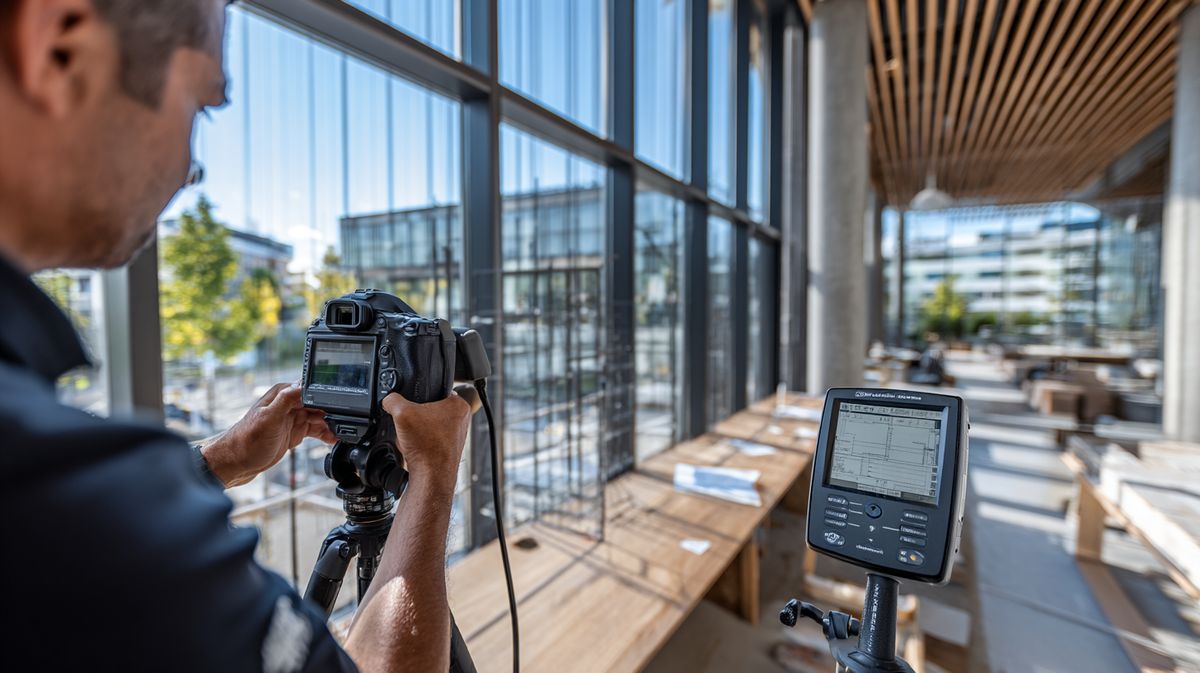
Frequently Asked Questions about Window Tint Meters
Why do I need a window tint meter?
If you're into customizing your vehicles or managing a fleet, a window tint meter is essential. It ensures that you're compliant with local and state laws regarding window tint levels. These regulations can vary significantly depending on where you live, and a tint meter provides the peace of mind that you're within legal thresholds.
How accurate are window tint meters?
Today's window tint meters are quite accurate, usually providing readings with a margin of error of around 1-2%. This precision is sufficient for ensuring compliance with most regional vehicle tinting regulations. However, ensure you use a well-maintained and calibrated device for the best results.
Can a window tint meter measure film before it's applied?
No, a window tint meter cannot measure tint film before application. It measures how much light passes through a surface, so the measurement can only be done once the film is applied to a window. For pre-application measurements, refer to the manufacturer's specification sheets for VLT percentages.
Are window tint meters pricey?
Window tint meters come in a range of prices depending on features and accuracy. Basic models are relatively inexpensive, making them accessible to hobbyists and small business owners. However, if you need additional features such as dual-light sources or Bluetooth capabilities, expect to pay a bit more. It's always a good idea to assess your needs before making a purchase.
Can window tint meters be used on all types of tinted windows?
Yes, window tint meters can be used on various types of tinted windows, whether they are in cars, homes, or commercial buildings. However, accuracy can vary with the thickness of the glass and the type of tinting material. It’s recommended to check manufacturer guidelines for compatibility with different surfaces.
How do I use a window tint meter?
Using a window tint meter is straightforward. Usually, you’ll need to place the meter’s transmitter and receiver on opposite sides of the tinted window. Switch on the device, and it will display the percentage of visible light that can pass through the glass. Always refer to the instruction manual as procedures can vary slightly between different models.
What are the regulations regarding window tint meter readings?
Regulations around window tint vary widely depending on the location. Generally, vehicle windows must allow a certain percentage of light to pass through. For example, front side windows might need a higher VLT compared to rear windows. Local DMV or law enforcement websites typically provide specific guidelines, and a tint meter helps you adhere to them.
How often should a window tint meter be calibrated?
For accurate readings, it's a good idea to calibrate your window tint meter regularly. Some manufacturers suggest doing this annually or after a set number of uses. Depending on your model, calibration might require a special kit or need to be sent to the manufacturer, while some advanced models might self-calibrate.
Do window tint meters require special maintenance?
Window tint meters are quite low-maintenance devices. Regularly check for damage and replace batteries as needed. Keeping the lens and light sensors clean ensures accurate readings. Always store the device in its case to protect it from physical damage and extreme temperatures.
Can police officers use window tint meters during traffic stops?
Yes, law enforcement officers frequently use window tint meters to enforce tint regulations during traffic stops. If a window tint meter indicates non-compliance with local laws, this might result in a ticket or fine. Therefore, maintaining a legal tint percentage is advisable.
Is it difficult to learn how to read a window tint meter?
Reading a window tint meter is usually intuitive. Once the device is correctly positioned on either side of the window, it gives a digital readout showing the percentage of light transmission. These devices are designed to be user-friendly, even for beginners, providing quick and accurate results.
What should I do if my window tint meter provides inconsistent readings?
If your window tint meter is giving inconsistent readings, first ensure that the glass surface is clean and that the device isn’t obstructed. Double-check the alignment between the sensor and receiver. If the issue persists, consult the user manual for troubleshooting steps, or reach out to the manufacturer for support. It might also be time for recalibration.

Pros
Accuracy in Measurement
One of the primary advantages of window tint meters is their ability to provide accurate measurements. These devices are calibrated to determine the exact percentage of visible light transmission (VLT) through a window, ensuring that vehicle owners and law enforcement can verify that a vehicle's tint complies with legal standards. This precision helps avoid fines and maintain road safety.
Easy to Use
Window tint meters are generally user-friendly. Most devices feature a simple, intuitive interface that requires minimal instruction. Usually, it's just a matter of placing the meter over the window and pressing a button to get a reading. This ease of use makes them accessible to a wide range of individuals, from automotive professionals to individual car enthusiasts.
Portability
These meters are often compact and lightweight, making them easy to carry around. This portability is particularly beneficial for law enforcement officers who need to conduct checks in various locations and for vehicle owners who might want to test the tint on different vehicles or in different settings.
Cost-Effective
For auto shops, law enforcement, and even consumers who frequently deal with window tinting, window tint meters can be a cost-effective solution. By ensuring compliance or aiding in installation, they can help prevent costly fines and rework.
Versatility
Window tint meters can measure Tints on various surfaces, not just vehicle windows. This versatility makes them useful in broader contexts, like testing glass in homes or office buildings, or any other area where light transmission measurement is needed.
Legal Compliance
With varying laws on tint levels across different states and countries, having a window tint meter helps ensure compliance. This is crucial for car dealerships, rental agencies, and inspection stations. These businesses can quickly test tint levels to ensure vehicles meet local regulations, thus avoiding legal issues and enhancing customer satisfaction.
Cons
Initial Cost
While window tint meters are cost-effective in the long run, the initial purchase price can be somewhat high, especially for high-quality or advanced models. This cost might discourage individual users or small businesses from investing in one.
Calibration Requirements
Maintaining the accuracy of a window tint meter means regular calibration. Over time, these devices can drift from their initial settings, affecting their precision. Calibration, which might require professional services, can be another expense and inconvenience.
Training and Proper Use
Although these devices are generally easy to use, ensuring proper utilization still requires a bit of training. Misuse could lead to inaccurate readings, leading to non-compliance or unnecessary adjustments.
Battery Dependency
Most window tint meters are battery-powered, which introduces the potential for operational downtime due to battery failure or depletion. This can be problematic in situations where immediate and repeated use is required.
Potential for Damage
As with any electronic device, window tint meters can be prone to damage if not handled properly. Dropping the meter or exposing it to harsh environmental conditions might impair its function. This risk necessitates careful handling and proper storage.
Limited Functionality
While extremely useful for measuring light transmission, window tint meters are specialized tools and don't offer any other function. This single-purpose nature can be seen as a downside for those who prefer multi-functional tools.
Variation in Measurement Quality
There is a wide range of window tint meters available on the market, and not all offer the same level of accuracy or durability. Some lower-cost models may produce inconsistent results, leading to compliance issues or necessitating replacement sooner than expected.

Myths and Misconceptions About Window Tint Meters
When it comes to window tint meters, there is undoubtedly a storm of myths and misconceptions swirling in the automotive world. Whether you're a car enthusiast or just a driver who loves a shaded interior, it's easy to get caught up in some of these half-truths and misunderstandings. Let’s dive into a few of the most prevalent myths and debunk them.
Myth 1: All Window Tint Meters Are the Same
A World of Diversity
One of the most common misconceptions is that all window tint meters operate in the same way and provide the same results. While it’s true that they all perform the fundamental task of measuring Visible Light Transmission (VLT), the truth is that there are variations in technology, accuracy, and additional features. Some meters utilize more advanced optics or electronics, making them more precise or easier to use in various lighting conditions.
Price Equals Quality
Another layer to this myth is the belief that a heftier price tag automatically means a better-quality meter. While investing in quality tools is always a smart move, some affordable options do an impressive job. The key is to consider your specific needs and do a bit of research to find a meter that balances cost and performance.
Myth 2: Using a Window Tint Meter is Complicated
User-Friendly Features Exist
For first-timers or the technologically challenged, a window tint meter might seem like a daunting gadget to operate. The truth, however, is that most modern meters are designed with user-friendly interfaces that simplify the whole process. Basic models often come with straightforward instructions and only a few buttons, making them accessible even for those who aren't tech-savvy.
Comprehensive Guides and Tutorials
Moreover, a plethora of resources are available, from online tutorials to detailed user manuals, that demystify the operation of these devices. Many manufacturers know their audience and are keen on providing video demonstrations and support, significantly flattening the learning curve.
Myth 3: Window Tint Meters Can Damage Tinted Windows
Non-Invasive Technology
A prevalent fear is that using a window tint meter could somehow damage the tinted film on your windows. In reality, the technology behind these meters is non-invasive. The devices typically measure light transmission without any need for physical contact that could scratch or peel the film.
Designed with Care
In many cases, the meter is only placed against the window temporarily, and because manufacturers design them with this function in mind, there's little to no risk of damaging your windows when the device is used correctly.
Myth 4: All States Have the Same Legal Tint Limits
Varied Regulations
One might think that window tint laws are standardized across the board, but regulations vary widely from state to state and even among different countries. This means that what's legal in one jurisdiction may be completely different just over the border.
Local Enforcement Differences
Not only do the legal limits vary, but how strictly these laws are enforced can differ significantly. Some locales might have stringent enforcement with frequent checks, while others might be more lenient.
Myth 5: You Only Need To Test the Front Windows
The Importance of Comprehensive Testing
While front windows often have the strictest regulations, it’s a mistake to think that testing only these is sufficient. Many laws require the entire vehicle’s tint to be within specific limits, not just the driver and passenger windows.
Potential Penalties
Neglecting to check the tint on rear-side or rear windows might lead to non-compliance fines or penalties, so it’s always best to perform a comprehensive check.
Myth 6: Tint Looks Darker to the Human Eye than What Meters Read
Perception vs. Reality
There’s a common belief that window tints appear darker to the human eye than what a tint meter would register. In fact, the opposite can sometimes be true—our eyes can be deceived by lighting conditions and the angles at which we view the tint.
Consistent Measurement
Tint meters provide a consistent, objective measurement that doesn’t change based on light conditions or human perception biases. This is essential for accurately adhering to legal standards.
Myth 7: Tint Meters Are Only for Car Shops and Law Enforcement
Available for All Enthusiasts
It's a widespread thought that only professionals need window tint meters. However, many car enthusiasts and regular drivers purchase their own meters for personal use. Having a tint meter can provide peace of mind or simply help you maintain compliance with local tint laws.
A Handy Tool for Everyone
Whether you’re a DIY modifier, someone buying a used car, or just curious about your vehicle’s tint levels, owning a tint meter can be incredibly useful.
So, the next time someone tells you a window tint meter myth, you'll be ready to separate fact from fiction armed with a solid understanding of the truth. Using tint meters correctly and understanding their purpose can ensure you’re on the right side of the law and getting the most out of your vehicle tint experience. Happy tinting!
Summary
Window tint meters are handy tools for both consumers and professionals. They help determine if your car's tint is within legal limits and make sure you're not driving around with windows that might catch the unwanted attention of law enforcement. Plus, if you're thinking about getting a tint, knowing how a meter works can guide you to make an informed choice before going too dark.
Moreover, window tint meters are super useful for businesses that install tints or check compliance. Companies can quickly and accurately check a vehicle's tint level, making sure everything is above board. This small device thus plays a big role in maintaining standards and ensuring everyone stays on the right side of regulations.
Ultimately, whether you’re a car owner, a mechanic, or someone who simply likes tools and gadgets, window tint meters are worth understanding. They're easy to use and can save you a lot of hassle in the long run. So, next time you think about your car’s tint, consider the role these little devices play in making life just a bit clearer.
About A+ Window Tinting
Welcome to A+ Window Tinting, your go-to destination in Roseville, CA, for all things window tinting! We are passionate about enhancing the comfort and style of your vehicles and properties with top-notch window film solutions. Our friendly team is dedicated to delivering exceptional service, ensuring a perfect fit and finish every time. Whether you're looking to reduce glare, increase privacy, or improve energy efficiency, we've got you covered with a wide selection of high-quality tinting options. At A+ Window Tinting, we take pride in our attention to detail and commitment to customer satisfaction, making sure you drive away with a smile! Swing by and let us give your windows the A+ treatment they deserve.

